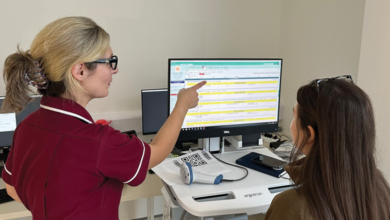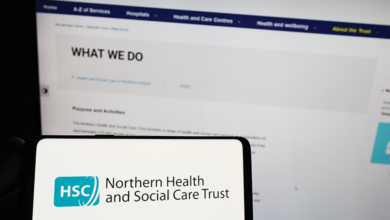Digital transformation at a time of crisis

Dan West, Chief Digital Information Officer (CDIO) at the Department of Health outlines the broader digital transformation agenda in health and care and discusses recent developments and acceleration in the context of Covid-19.
Appointed in late April 2019, Dan West had less than a year to settle into the role of CDIO for health and social care in Northern Ireland before the pandemic took hold. The appointment of a senior leader in digital was a new departure for the health and social care sector, indicating a commitment to digital transformation to deliver better outcomes and economic sustainability, West suggests.
“It’s important not to underestimate the challenge with that. Northern Ireland has about 80,000 HSC staff members doing incredible things every day. They are all incredible people, and we are all very appreciative of what they are doing, particularly at the moment.
“However, Northern Ireland also has the longest waiting lists in Europe for elective procedures and the highest age-adjusted per capita healthcare costs in the UK. Even with just those two macroeconomic indicators, we have got a lot of work to do in transforming health and care services,” he says.
Contextualising digital transformation, the CDIO explains the organisational architecture of health and social care in Northern Ireland. West defines ‘the centre’ of the health and social care sector as being the Department of Health, the Health and Social Care Board and the Public Health Agency and the Business Services Organisation. Similarly, he defines ‘local’ as being the six providers trusts and the primary care tier.
Since his arrival at the Department of Health, the CDIO has established Digital Health and Care for Northern Ireland (DHCNI), a joint venture between the Department of Health, the Health and Social Care Board and the Public Health Agency. The DHCNI team has six main strategic goals, including: mobilising the workforce; enabling locations and capacity; informing and supporting the public; developing data and insights; supporting vulnerable people; and enabling a recovery strategy.
- Mobilising the workforce: This goal relates to the delivery of devices and upgrading of central infrastructure and systems to allow critical staff members to work remotely. “One example of the things we have done there is increasing the capacity of our remote access VPN connections and rearchitecting our access solutions,” West explains.
- Enabling locations and capacity: This strategic priority is about repurposing and enabling locations in order to augment the capacity of Health and Social Care organisations and support the provider trusts to maintain elective services. This included “allowing MOT drive-in centres to be repurposed as virological testing centres and allowing private sector provider organisations to be able to get access to data and facilities to be able to sustain our out-patient capacity during the course of Covid”.
- Informing and supporting the public: This priority is about understanding how citizens interact with information and services and reducing the burden on frontline staff through alternative telephone and digital channels.
- Developing data and insights: Understanding the flow of information through providing consistent access and toolsets for analysis can support organisations in planning and responding to the Covid-19 pandemic.
- Supporting vulnerable people: The shielded population, those individuals with either chronic long-term conditions that require particular protection from the impact of the virus, or frail, elderly patients require particular attention. “Once you identified those individuals and provided advice to them, there was a need to be able to provide additional information and services. This preceded the creation of a new registry and the creation of services to interact with that registry,” the CDIO clarifies.
- Enabling a recovery strategy: This was about transitioning from the scenario facing health and care at the peak of the Covid-19 pandemic and restoring “some semblance of normality”. This involved establishing a set of services around testing and tracing in order to break transmission chains and reduce the impact of infectivity on the population.
Reflecting on the health and care response to the pandemic, the CDIO emphasises the creation of a “a series of completely novel digital services” that had not previously existed. These services include those firstly, to identify outbreaks of the virus in the community and secondly, to react through the provision of advice and guidance to individuals in order to break transmission chains.
“One of the things we did was build the COVIDCare NI app for individuals seeking advice and guidance or looking for a symptom checker experience. They can go through that experience on an app or a website rather than necessarily having to have a telephone conversation with a healthcare employee.
“Within the COVIDCare NI app, we also inserted an AI-based chatbot so that people could search through all of the rapidly evolving, and sometimes complex, guidance and policy relating to their own personal circumstances and questions,” West says.
West’s team then built the Northern Ireland Testing Registry as a single database of all the virological testing results. “In October 2020 alone, we processed 250,000 testing results and we matched those back to patient records,” he adds.
Designed to anonymously contact people who have been in close proximity to another individual who has tested positive for Covid-19, the StopCOVID NI proximity app was the first of its kind in the UK. “The app uses low-power Bluetooth technology on your phone to get a bit of a history of individuals that you have been close to. If one of those individuals gets a positive test, it identifies people who are at risk and provides advice on when to self-isolate.
“Northern Ireland also has the longest waiting lists in Europe for elective procedures and the highest age-adjusted per capita healthcare costs in the UK… we have got a lot of work to do in transforming health and care services.”
— Dan West, Chief Digital Information Officer, Department of Health
“It supports and runs alongside the manual contact tracing processes. It was also the first intercountry production interoperability between two proximity apps, embracing the Google and Apple exposure notification API, globally. Likewise, it was the first app to be designed and specifically deployed to the 11 to 17-year old, post primary education sector,” West notes.
Similarly, Digital Self-Trace (DST) is an online contact tracing service which supports the manual contact tracing teams. “DST is an alternative to public health doctors contacting everyone who has a positive test and having a conversation about where they have been and who their close contacts are, in order to advise those individuals to self-isolate.
“As we scale out the volume of testing taking place and we scale out the number of people who are infected by the virus, as we saw during the marked spike in October, shifting to a digital tracing format will be helpful,” the CDIO adds.
Alongside a brand new Microsoft Dynamics-based, cloud-hosted contract tracing platform which is a technology that supports the workflow of the Public Health Agency and public health doctors in delivering contact tracing services, West’s team has built another cloud-based, Azure-hosted Power BI analytics environment. “This incorporates all of the datasets about the flow of work and the flow of data in relation to these digital services and matching that with the testing datasets and other population health datasets to inform calculation of the reproduction rate and to inform the policy agenda,” he concludes.






